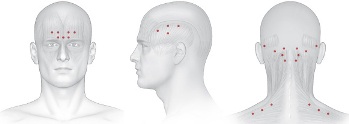Botulinium Toxin use to temporarily paralyze muscle activity. This toxin is produced by the microbe that causes botulism, a type of food poisoning.
Noted primarily for the ability to reduce the appearance of some facial wrinkles, Botulinium Toxin injections are also used to treat such problems as repetitive neck spasms (cervical dystonia), excessive sweating (hyperhidrosis), overactive bladder and some causes of crossed eyes. Botulinium Toxin A injections may also help prevent chronic migraines in some people.
Botulinum toxin injections block certain chemical signals from nerves, mostly signals that cause muscles to contract. The most common use of these injections is to temporarily relax the facial muscles that underlie and cause wrinkles, such as:
Frown lines between the eyebrows
Crow's-feet, the lines that fan out from the corners of the eyes
Forehead furrows, the horizontal lines that form when you raise your eyebrows
In addition to these cosmetic procedures, which simply improve your appearance, botulinum toxin injections have also been used to treat conditions that affect how your body functions. Examples include:
Cervical Dystonia: In this painful condition, your neck muscles contract involuntarily causing your head to twist or turn into an uncomfortable position.
Lazy Eye: The most common cause of lazy eye is an imbalance in the muscles responsible for positioning the eye. This can result in crossed eyes.
Muscle Contractures: Some neurological conditions, such as cerebral palsy, can cause your limbs to pull in toward your center. In some cases, these contracted muscles can be relaxed with botulinum toxin injections.
Hyperhidrosis: In this condition, excessive sweating occurs even when the temperature isn't hot and you're not exercising. In some people, the sweat literally drips off their hands.
Chronic Migraine: If you experience migraines more than 15 days a month, botulinum toxin injections may help reduce headache frequency.
Bladder Dysfunction: Botulinum toxin injections can also help reduce urinary incontinence caused by an overactive bladder.
Injections should be divided across 7 specific head/neck muscle areas as specified in the diagrams and Table 2 below. A thin needle may be needed in the neck region for patients with thick neck muscles. With the exception of the procerus muscle, which should be injected at one site (midline), all muscles should be injected bilaterally. The recommended re-treatment schedule is every 12 weeks.
Table - Dosing by Muscle for Chronic Migraine Head/Neck Area Recommended Dose (Number of Sites )
Botulinium Toxin injections are relatively safe when performed by an experienced doctor. The most common side effects include swelling or bruising at the injection site, headache or flu-like symptoms. If the injections aren't placed correctly, the medication may spread into adjacent tissues and cause problems such as:
Eyelid droop
Cockeyed eyebrows
Crooked smile
Dry eye or excessive tearing
Although very unlikely, there is a possibility that the effect of botulinum toxin may spread to other parts of the body and cause botulism-like signs and symptoms. Call your doctor right away if you notice any of these effects hours to weeks after receiving Botulinium Toxin:
Muscle weakness all over the body
Vision problems
Trouble speaking or swallowing
Trouble breathing
Loss of bladder control
Doctors generally recommend against using Botulinium Toxin when you're pregnant or breast-feeding, since the effects on the baby aren't known.
Botulinium Toxin must be used only under a doctor's care. It can be dangerous if it's administered incorrectly. Ask for a referral from your primary care doctor or look for a doctor who specializes in your condition and who has experience in administering Botulinium Toxin treatments. A skilled and properly certified doctor can advise you on the procedure and can help determine if it best suits your needs and health.
Botulinum toxin injections usually begin working a few days after treatment. Depending on the problem being treated, the effect may last for three to 12 months. To maintain the effect, you'll need regular follow-up injections.


